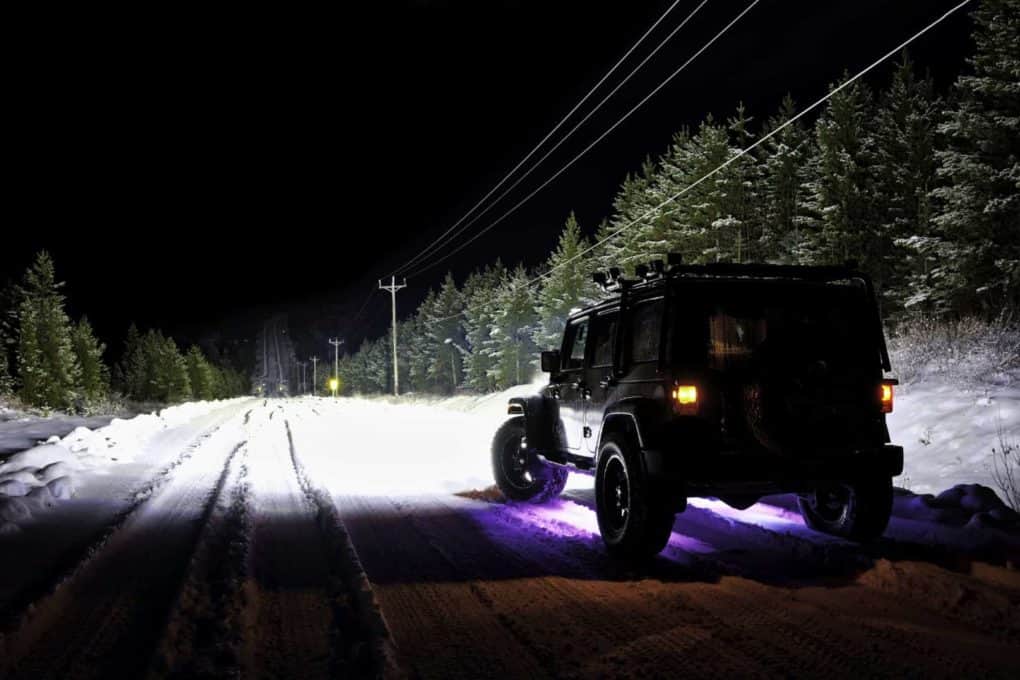When driving at night, having the right headlights can make all the difference. The color temperature of your headlights, measured in Kelvin (K), affects how well you see and how safe you feel on the road. This article compares three popular color temperatures—4300K, 5800K, and 6500K—to help you choose the best option for your nighttime driving needs.
Key Takeaways
- 4300K provides a warm light that reduces eye strain, making it great for long drives.
- 5800K offers a balanced white light that enhances visibility without too much glare.
- 6500K gives a cool, bright light ideal for highways but can cause more glare for oncoming drivers.
- Choosing the right color temperature can improve safety and comfort while driving at night.
- Consider local laws and personal preferences when selecting headlight color temperatures.
Understanding the Importance of Color Temperature in Night Driving
Definition and Measurement of Color Temperature
Color temperature is a way to describe the color of light emitted by a source, measured in Kelvin (K). It helps us understand how warm or cool the light appears. For example, a lower Kelvin number means a warmer, yellowish light, while a higher number indicates a cooler, bluish light.
Impact on Visibility and Safety

Choosing the right color temperature for headlights is crucial for visibility and safety while driving at night. Here’s how different temperatures can affect your experience:
- 4300K: Offers a warm light that reduces eye strain, making it easier to see in various conditions.
- 5800K: Provides a neutral white light that enhances contrast, helping drivers spot road signs and obstacles.
- 6500K: Emits a bright, cool light that can improve visibility but may cause glare for oncoming traffic.
Common Misconceptions About Color Temperature
Many people think that a higher color temperature means brighter light, but that’s not always true. Brightness is influenced by other factors, such as the bulb's design and power. Here are some common myths:
- Higher Kelvin equals higher brightness: Not necessarily; brightness depends on the bulb's output.
- Cooler light is always better: While it can enhance visibility, it may also increase glare.
- All headlights are the same: Different temperatures serve different purposes, and choosing the right one is essential for safety.
Driving off-road, especially at night, can be taxing on the eyes. A warmer color temperature can reduce eye fatigue during prolonged use.
Characteristics of 4300K LED Headlights
Warm White Light with Yellow Tint
4300K LED headlights produce a warm white light with a slight yellow tint. This color closely resembles traditional halogen bulbs, making it a familiar choice for many drivers. The warm glow is inviting and can enhance the overall driving experience.
Advantages for Night Driving
- Enhanced Color Rendering: The warm light helps you see colors more clearly, making it easier to spot road signs and hazards.
- Reduced Eye Strain: The gentle light is easier on the eyes, which can help you feel less tired during long drives.
- Minimized Glare: Compared to higher color temperatures, 4300K headlights create less glare for oncoming traffic, making night driving safer.
Potential Drawbacks
- Slightly Reduced Visibility Range: While 4300K provides good illumination, it may not reach as far as higher color temperatures, making distant objects harder to see.
- Perceived as Less Modern: Some drivers may prefer the cooler look of higher color temperatures, viewing 4300K as less stylish.
The 4300K LED headlight is a great choice for those who want a balance of visibility and comfort while driving at night. It offers a friendly light that is less harsh on the eyes, making it suitable for various driving conditions.
Features of 5800K LED Headlights
Pure White Light with Blue Tint
5800K LED headlights emit a pure white light with a slight blue tint, making them a popular choice among drivers. This color temperature strikes a balance between the warm glow of 4300K and the cooler tones of 6500K, providing a modern look while enhancing visibility.
Benefits for Nighttime Visibility
- Enhanced Visibility: The bright, clear light helps illuminate the road, making it easier to see potential hazards, road signs, and markings.
- Balanced Color Rendering: The slight blue tint improves contrast, allowing colors to appear more vibrant and natural.
- Modern Aesthetic Appeal: Many car enthusiasts appreciate the sleek, contemporary look that 5800K headlights provide, especially on newer models.
Possible Downsides
- Slight Increase in Glare: Compared to 4300K, 5800K headlights may cause a bit more glare for oncoming drivers, so proper aiming is essential.
- Potential Legal Concerns: Always check local regulations regarding headlight color temperatures to avoid any legal issues.
Choosing the right color temperature for your headlights can significantly impact your driving experience, especially at night. 5800K offers a great balance of visibility and style.
Advantages and Disadvantages of 6500K LED Headlights
Cool White Light with Prominent Blue Tint
6500K LED headlights shine with a cool white light that has a noticeable blue tint. This gives them a modern and stylish look, making them popular among car enthusiasts who want their vehicles to stand out.
Enhanced Visibility and Modern Aesthetic
- Extended Visibility Range: The cool white light can reach further than lower color temperatures, helping drivers see distant objects more clearly, especially on highways.
- High-Tech Appearance: The blue tint provides a futuristic look, appealing to those with modern or sporty cars.
- Increased Perceived Brightness: Although the actual lumens may be similar to other options, the cool light can feel brighter, enhancing the driving experience.
Challenges and Considerations
- Reduced Color Rendering: The strong blue tint can wash out colors, making it harder to see road signs and markings, especially in bad weather.
- Increased Glare for Oncoming Traffic: The brightness can create more glare for other drivers, which is a safety concern. Proper aiming is essential to reduce this issue.
- Potential Legal Restrictions: Some areas have laws about headlight color temperatures. It's important to check local regulations to avoid legal problems.
Choosing the right LED headlight color temperature is crucial for safety and visibility. Always consider your driving conditions and local laws when making a decision.
Choosing the Right LED Headlight Color Temperature for Your Needs
When selecting the best LED headlight color temperature for your vehicle, it’s essential to consider several factors that can affect your driving experience. Your choice can significantly impact visibility and safety. Here’s what to keep in mind:
Factors to Consider
- Visibility and Illumination: Look for headlights that provide excellent visibility in various conditions. This includes checking the beam pattern and light output.
- Color Rendering and Contrast: Choose a color temperature that helps you see objects and road signs clearly.
- Glare Reduction: Opt for headlights that minimize glare for other drivers, ensuring a safer environment for everyone.
- Legal Compliance: Make sure the headlights you choose meet local regulations.
- Personal Preference and Aesthetics: Consider how the color temperature fits with your vehicle’s style.
Matching Color Temperature to Driving Conditions
|
Driving Condition |
Recommended Color Temperature |
|
Clear Nighttime Driving |
6500K |
|
Adverse Weather |
4300K |
|
Urban Driving |
5800K |
Choosing the right headlights is crucial for a safe night driving experience. Consider your specific needs and local laws before making a decision.
By understanding these factors, you can make an informed choice that enhances your night driving experience while ensuring safety on the road. Remember, your headlights are not just about style; they play a vital role in your overall driving safety.
Comparing 4300K, 5800K, and 6500K for Different Driving Scenarios
Highway and Open Road Driving
When driving on highways or open roads, 6500K headlights are often the best choice. They provide a bright, cool light that enhances visibility, making it easier to see distant objects and road signs. Here’s a quick comparison:
|
Color Temperature |
Visibility |
Comfort Level |
Glare Potential |
|
4300K |
Good |
High |
Low |
|
5800K |
Better |
Moderate |
Moderate |
|
6500K |
Best |
Low |
High |
Urban and Suburban Settings
In urban areas, 5800K headlights are often preferred. They offer a balance of brightness and comfort, making them suitable for navigating city streets. Here are some key points:
- Improved visibility for road signs and pedestrians.
- Reduced glare for oncoming traffic compared to 6500K.
- Modern appearance that enhances vehicle aesthetics.
Adverse Weather Conditions
For driving in rain, fog, or snow, 4300K headlights are recommended. They provide a warm light that penetrates better through adverse weather. Consider these benefits:
- Enhanced contrast in low visibility conditions.
- Less glare for other drivers, promoting safety.
- Comfortable light that reduces eye strain during long drives.
Choosing the right color temperature for your headlights can significantly impact your night driving experience. Understanding your driving conditions is key.
Conclusion
In summary, picking the right LED headlight color temperature for night driving really comes down to what you need and like. The 4300K option gives off a warm light that feels cozy and helps reduce glare, making it a great choice for comfort and safety. If you want a mix of visibility and style, the 5800K is a solid pick, providing a bright white light that works well for nighttime driving. On the other hand, the 6500K offers a cool, modern look and better visibility, but it might create more glare for other drivers.
When deciding, think about things like how well you can see, how colors appear, and how much glare you want to avoid. Also, make sure to check local laws about headlight colors and invest in good-quality bulbs. Remember, your headlights are key to a safe and enjoyable night driving experience.
Frequently Asked Questions
What is color temperature in headlights?
Color temperature refers to how warm or cool the light looks. It’s measured in Kelvin (K). Lower numbers like 4300K are warmer and yellower, while higher numbers like 6500K are cooler and bluer.
Which color temperature is best for night driving?
It depends on your needs. 4300K is warm and gentle on the eyes, 5800K is a good balance, and 6500K is bright and modern but can cause glare.
Can higher color temperatures cause glare?
Yes, higher temperatures like 6500K can create more glare for other drivers, which can be dangerous.
Is 4300K good for all weather conditions?
Yes, 4300K headlights work well in rain, fog, and mist because their warm light cuts through bad weather better.
Are there any legal issues with using 6500K headlights?
Some places have laws about headlight color. It’s important to check local regulations before installing 6500K lights.
How do I choose the right color temperature for my headlights?
Consider your driving conditions, personal comfort, and local laws. Think about whether you want warm light for comfort or bright light for visibility.


